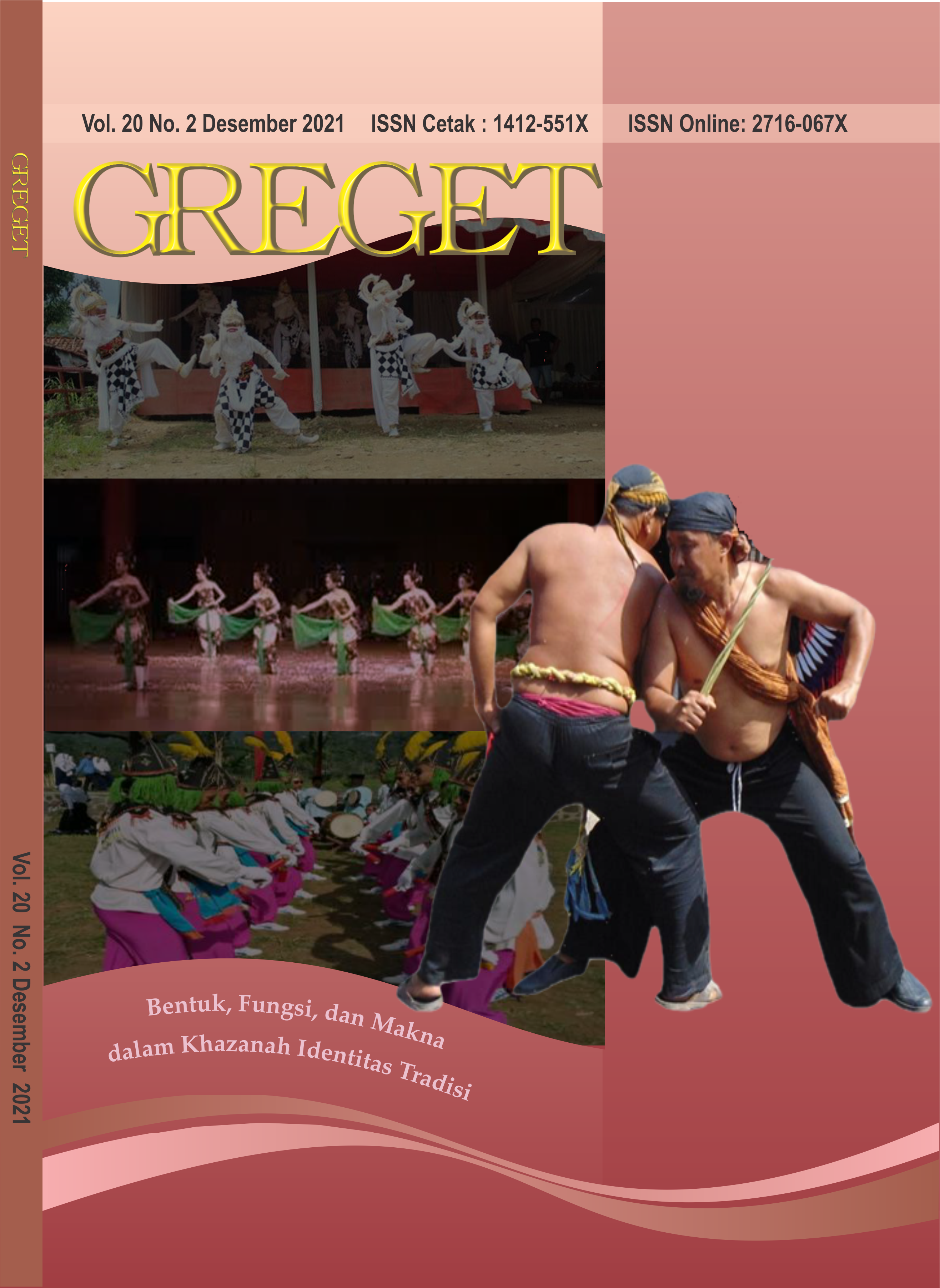ELEMEN-ELEMEN KOREOGRAFI DAN REFLEKSI DALAM SAJIAN KARYA TARI TUNJUNG PUTIH
Main Article Content
Abstract
Tunjung Putih dance by the choreographer; Divany Rico Jhosua in 2020 is a new traditional art whose dance work creation is motivated by the problem of social discrimination experienced by cross-dressers and cross-gender dancers. The idea of creating this work is the story of Wrahatnala's character while posing as a woman and acting like a sissy. To find out the elements of choreography in Tunjung Putih dance, the author uses the concept presented by Y. Sumandyo Hadi, namely the explanation of the concepts of cultivation through the elaboration of choreographic elements. The result of this study is to know the form of Tunjung Putih dance through the description of 11 elements of choreography in it. Reflection of the creation of Tunjung Putih dance in the form of critical analysis with further research to respondents on issues and responses related to the presentation of this dance work.
Downloads
Article Details
Copyright
Authors who publish with GREGET agrees to the following terms:
- Authors retain copyright and grant the journal right of first publication with the work simultaneously licensed under a Creative Commons Attribution-ShareAlike 4.0 (CC BY-SA 4.0) that allows others to share the work with an acknowledgment of the work's authorship and initial publication in this journal.
- Authors are able to enter into separate, additional contractual arrangements for the non-exclusive distribution of the journal's published version of the work (e.g., post it to an institutional repository or publish it in a book), with an acknowledgment of its initial publication in this journal.
- Authors are permitted and encouraged to post their work online (e.g., in institutional repositories or on their website) prior to and during the submission process, as it can lead to productive exchanges, as well as earlier and greater citation of published work.
References
Darmasti. 2020. “Nyi Bei Madusari Dalam Langendriyan Mangkunegaran: Sebuah Tinjauan Mengenai Kualitas Kepenarian Silang Karakter.” Dewa Ruci, Jurnal Pengkajian dan Penciptaan Seni Vol.6 No.2 (Juli 2010):295-323.
Dewi, Nora Kustantina, dkk. 1993. “Tari Bedhaya Ketawang Sebagai Induk Munculnya Tari Bedhaya Lain di Surakarta dan Perkembangannya (1839-1930).” Laporan Penelitian Kelompok Sekolah Tinggi Seni Indonesia, Surakarta.
____________________. 2001. “Tari Bedhaya Ketawang Legimitasi Kekuatan Raja Surakarta.” Harmonia, Jurnal Pengetahuan dan Pemikiran Seni Vol.2 No.3 (Desember 2001):29-36.
Hadi, Y Sumandiyo. 2003. Koreografi Kelompok. Yogyakarta: ELKAPHI Lembaga Kajian Pendidikan dan Humaniora Indonesia.
_______________. 2007. Kajian Tari Teks dan Konteks. Yogyakarta: Pustaka Book Publisher
Hanna, Judith Linne. 1994. Peran Sifat Jasmaniah Pria dan Wanita Pada Tari. Surakarta: STSI Surakarta. Terjemahan Agus Tasman dan Basuwarno.
Hawkins, Alma M. 2003. Bergerak Menurut Kata Hati Metode Baru Dalam Mencipta Tari. Jakarta: Ford Foundation dan Masyarakat Seni Pertunjukan Indonesia. Terjemahan I Wayan Dibia.
Kresna, Ardian. 2013. Drupadi. Yogyakarta: DIVA Press.
Maryono. 2015. Analisa Tari, Surakarta: ISI Press.
Rajagopalachari, C. 2013. Mahabharata. Bandung: IRCiSoD. Terjemahan Yudhi Murtanto.
Rustopo. 1990. “Gendhon Humardani (1923-1983). Arsitek dan Pelaksana Pembangunan Seni Tradisi Jawa Yang Moderen Mengindonesia: Suatu Biografi.” Tesis S-2 Program Studi Sejarah Jurusan Ilmu-ilmu Humaniora Universitas Gadjah Mada, Yogyakarta.
S. Pendit, Njoman. 1970. Mahabharata. Jakarta: PT. Gramedia Pustaka Utama.
Sapriana, Ika. 2010. “Identitas Penari Cross Gender dalam Kehidupan Masyarakat di Surakarta.” Skripsi S-1 Program Studi Pendidikan Sosiologi-Antropologi Jurusan Pendidikan Ilmu Pengetahuan Sosial Universitas Sebelas Maret, Surakarta.
Widyastutieningrum, Sri Rochana dan Dwi Wahyudiarto. 2014. Pengantar Koreografi. Surakarta: ISI Press.
Widyawati, Setya. 1994. “Pengantar Pengetahuan Tari (Sebuah Studi Pustaka).” Laporan Penelitian (Karya Ilmiah) Sekolah Tinggi Seni Indonesia, Surakarta.
